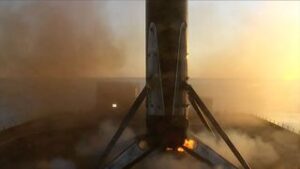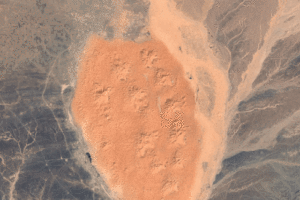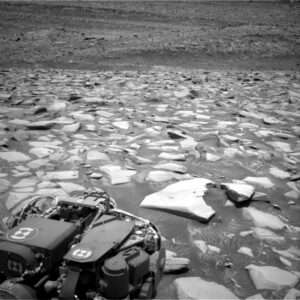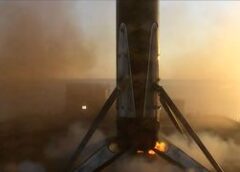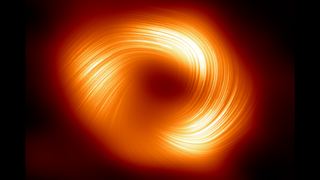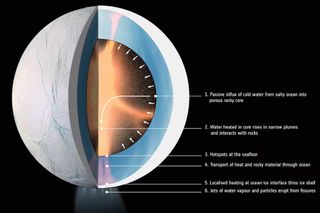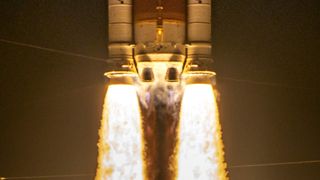Students from Universidad Católica Boliviana prepare to traverse the course at the 2024 Human Exploration Rover Challenge at the U.S. Space & Rocket Center in Huntsville, Alabama, near NASA’s Marshall Space Flight Center. Credits: NASA/Taylor Goodwin NASA announced the winners of the 30th Human Exploration Rover Challenge (HERC) April 22, with Parish Episcopal School, from Dallas, winning first place in the high school division, and the University of Alabama in Huntsville, capturing the college/university title. The annual engineering competition – one of NASA’s longest standing challenges – held its concluding…
Read MoreScientists use AI to reconstruct energetic flare blasted from Milky Way’s supermassive black hole
Scientists have used artificial intelligence to construct a three-dimensional model of an energetic outburst, or flare, that occurred around the Milky Way’s central black hole, Sagittarius A* (Sgr A*). This 3D model could help scientists develop a clearer picture of the tumultuous environment that forms around supermassive black holes in general. The material swirling around Sgr A* exists in a flattened structure called an “accretion disk” that can periodically flare. These flares occur across a range of light wavelengths, all the way from high-energy X-rays to low-energy infrared light and…
Read MoreOur Beautiful Water World
Behold one of the more detailed images of Earth. This Blue Marble Earth montage—created from photographs taken by the Visible/Infrared Imager Radiometer Suite (VIIRS) instrument aboard the Suomi NPP satellite—shows many stunning details of our home planet.
Read MoreSaturn’s ocean moon Enceladus is able to support life − my research team is working out how to detect extraterrestrial cells there
This article was originally published at The Conversation. The publication contributed the article to Space.com’s Expert Voices: Op-Ed & Insights. Fabian Klenner is a planetary scientist and astrobiologist at the University of Washington (UW). His research focus lies on the exploration of icy moons in the solar system, in particular Saturn’s moon Enceladus and Jupiter’s moon Europa. Saturn has 146 confirmed moons – more than any other planet in the solar system – but one called Enceladus stands out. It appears to have the ingredients for life. From 2004 to 2017, Cassini –…
Read MoreWhy is it so hard to send humans back to the moon?
Between 1969 and 1972, the Apollo missions sent a total of a dozen astronauts to the surface of the moon — and that was before the explosion of modern technology. So why does it seem like our current efforts, as embodied by NASA’s Artemis program, are so slow, halting and complex? There isn’t one easy answer, but it comes down to money, politics and priorities. Let’s start with the money. Yes, the Apollo missions were enormously successful — and enormously expensive. At its peak, NASA was consuming around 5% of…
Read MoreEclipse expert Jamie Carter wins media award for extensive solar eclipse coverage
Anyone who has been keeping up with our solar eclipse content in the lead-up to April 8’s total solar eclipse will undoubtedly be familiar with the name Jamie Carter. After all, he’s our ‘go-to’ eclipse expert and valued contributor to Space.com and has written over 35 total solar eclipse pieces in the last few months for Space.com alone. We’re thrilled to announce that his hard work for us and other news outlets, such as Forbes, has paid off with Carter being awarded the Solar Physics Division (SPD) Popular Media Award…
Read MoreCosmonaut Muhammed Faris, first Syrian in space, dies at 72
Muhammed Faris, who was the first cosmonaut from Syria and second Arab to fly into space, has died at the age of 72. Faris’ death on Friday (April 19) was reported by Syrian media. According to the reports, he died as a result of a long illness in Türkiye, where had been living as a refugee since 2012. Selected in 1985 as part of the Soviet Union’s Interkosmos program, Faris lifted off on his first and only spaceflight on July 22, 1987. Launching on board Soyuz TM-3 with cosmonauts Aleksandr…
Read MoreThis Week In Space podcast: Episode 107 — Mars Sample Return Blues
On Episode 107 of This Week In Space, Rod and Tariq talk with journalist Leonard David about NASA’s troubled Mars sample return mission. The robotic program has its roots in the 1960s, when NASA started thinking about sending robots to fetch Mars soil even before Mariner 4’s first flyby of the planet. The Russians pondered it as well, as the Chinese and Japanese are today. The problem? It’s really hard, with multiple spacecraft, possibly on different launches, rendezvousing around the Red Planet to accomplish. And then there are the concerns…
Read MoreLego Star Wars Millennium Falcon (2024) review
Essential info: Price: $84.99/£74.99 Model number: 75375 Number of pieces: 921 Dimensions: 5 x 9.5 x 7.5 inches / 13 x 24 x 19cm Recommended age: 18+ We’ve counted and, not including various freebies, magazine giveaways and random spin-off models, there have been no less than 14 Lego Millennium Falcons in the last 25 years. That’s more than one every two years — few other sets have been recreated so many times. We’ve no doubt that more are still to come, but 2024’s Lego Millennium Falcon, released to celebrate the…
Read MoreNASA’s Juno probe captures amazing views of Jupiter’s volcanic moon Io (video)
The four biggest moons of Jupiter aren’t just blurry smudges in Galileo’s telescope anymore. The Italian astronomer Galileo Galilei discovered Ganymede, Callisto, Europa and Io back in 1610, which explains why they’re called the Galilean moons. We’ve learned a lot about these exotic bodies in the past 400 years thanks to ever-improving telescope views and close-up imagery snapped by voyaging spacecraft like NASA’s Juno Jupiter orbiter. Indeed, Juno recently conducted two close flybys of Io, the most volcanically active body in the solar system, and data from the encounters is…
Read More